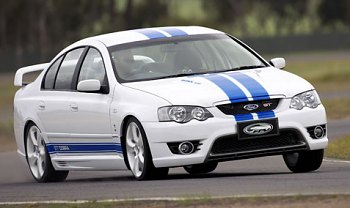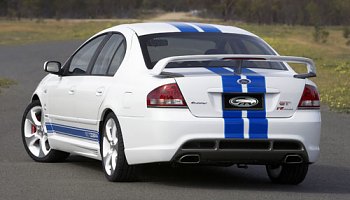 Reading
the press release material of the latest Ford AU Falcon made me laugh.
Its hard-selling style did nothing to me but negates my good impression
about this car. Reading
the press release material of the latest Ford AU Falcon made me laugh.
Its hard-selling style did nothing to me but negates my good impression
about this car.
In the beginning, it spent thousands of words to describe the styling as "New Edge" design. Don't fool me ! Except the headlamps, the new Falcon strictly follows the Taurus School's curvy-is-beautiful philosophy. Yes, in many ways it looks like the American Taurus - long and big, curvy, with steeply-tilted windscreen and rear window, and lack of aggression. As usual, this school has little compassion to the space efficiency : while the roof has been raised for 20 mm, the rear head room gains just 2.5 mm. Anyway, at least the smooth body helps improving the aerodynamic drag to 0.30. Then, the press release spent another thousand words to describe how superior the independent rear suspension is. (Oddly, Australian still used to call this as IRS, while European and Asian have long forgotten this short write because it has been standardized in there for one and a half decade.) As last year's Holden Commodore VT introduced IRS, Ford follows by installing double wishbones suspensions to all corners in the higher-spec Falcon, and makes it optional to most other versions. However, since Falcon will continue to be offered as taxi, a low-cost, highly reliable non-independent live-axle rear suspension (with Watts link) will continue to serve the bottom of the range. In the past, there's die-hard Falcon lovers defended the car's non-IRS by saying that IRS cannot cope with Australian rough roads. As both Commodore and Falcon have switched to IRS, it's time to shut up. There's some very minor modifications to the 4-litres single-cam in-line 6 and the pushrod 5-litre V8. However, since I'm not Ford's salesman so I'm not going to discuss more about these trivial bits. The only new item worths mentioning is the adoption of variable cam timing (VCT) to Falcon XR6's in-line 6, raising power to 230hp at 300rpm higher than the standard engine. My memory tells me this is probably the first ever 2-valve engine equipped with VVT, and perhaps will be the last one also. The reason that Ford uses VCT is obvious : it wants to improve the output but couldn't afford to develop an all-new 4-valve engine. By the way, the whole development budget for Falcon is just 270 million pounds. Another joke from the press release is : "Overall length reduced 10mm - ease of parking." Pardon ? Reduced by how much ? The joke stops
here. Back
to the car itself, Autocar's Australian correspondent reported quite
good
impression. He said the huge Falcon displays better dynamic than the
Taurus.
Steering weight consistently and turns accurately. Good brakes.
Improved
body control. The abundance of torque mated with the popular automatic
gearbox delivers effortless performance. |
| The above report was last updated in 1998. All Rights Reserved. |
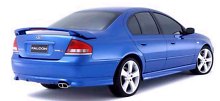
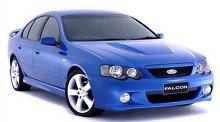 <
Falcon XR8
<
Falcon XR8
 XR6
T (T for Turbo) is not the top of the range - that belongs to the
V8-power
XR8 - but it is definitely our pick of the range, thanks to its superb
value for money. In Australia, it is sold at just 44,000 Australian
dollars,
more than 10% cheaper than the equivalent Holden Commodore SS and of
course
far cheaper than Western imports. For so little money, you get a 322
horsepower
engine and a lot of metal, Australian must love it very much.
XR6
T (T for Turbo) is not the top of the range - that belongs to the
V8-power
XR8 - but it is definitely our pick of the range, thanks to its superb
value for money. In Australia, it is sold at just 44,000 Australian
dollars,
more than 10% cheaper than the equivalent Holden Commodore SS and of
course
far cheaper than Western imports. For so little money, you get a 322
horsepower
engine and a lot of metal, Australian must love it very much.
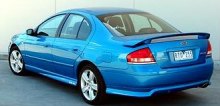 Having
understood its philosophy, we examine its mechanical design. XR6 T’s
engine
is derived from the base Falcon. That means the same 4.0-litre
straight-six,
with 24 valves and continuous VVT at both camshaft. On the top of that,
a Garrett roller bearing turbocharger is added, accompany with an
air-to-air
intercooler. This is a light pressure turbo, running at just 1.4 bar,
thus
turbo lag is nearly non-existent, throttle response is instantaneous,
unlike
those small-capacity-big-turbo Japanese motors. From the torque curve
we
can also see it has a very good manner: maximum torque of 332 lbft
arrives
early from 2000rpm all the way to 4500rpm. Power delivery is smooth and
linear. Maximum power of 322 hp arrives at 5250 rpm. The only slight
disappointment
is that it cannot rev much beyond 6000rpm, otherwise it would have been
even more thrilling. Even so, the turbo straight-6 is already a
remarkable
engine.
Having
understood its philosophy, we examine its mechanical design. XR6 T’s
engine
is derived from the base Falcon. That means the same 4.0-litre
straight-six,
with 24 valves and continuous VVT at both camshaft. On the top of that,
a Garrett roller bearing turbocharger is added, accompany with an
air-to-air
intercooler. This is a light pressure turbo, running at just 1.4 bar,
thus
turbo lag is nearly non-existent, throttle response is instantaneous,
unlike
those small-capacity-big-turbo Japanese motors. From the torque curve
we
can also see it has a very good manner: maximum torque of 332 lbft
arrives
early from 2000rpm all the way to 4500rpm. Power delivery is smooth and
linear. Maximum power of 322 hp arrives at 5250 rpm. The only slight
disappointment
is that it cannot rev much beyond 6000rpm, otherwise it would have been
even more thrilling. Even so, the turbo straight-6 is already a
remarkable
engine. 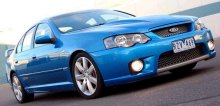 FPV
- Ford Performance Vehicles - is a joint-venture between UK's Prodrive
and Ford Australia. It is equivalent to Holden's HSV. FPV's GT-P is a
small-scale
production. Derived from the standard Falcon XR8, offering 40 more
horsepower
and with a sportier chassis setup to match, the GT-P sits on the top of
the Falcon family chart. This is the ultimate performance machine of
Australian
Ford.
FPV
- Ford Performance Vehicles - is a joint-venture between UK's Prodrive
and Ford Australia. It is equivalent to Holden's HSV. FPV's GT-P is a
small-scale
production. Derived from the standard Falcon XR8, offering 40 more
horsepower
and with a sportier chassis setup to match, the GT-P sits on the top of
the Falcon family chart. This is the ultimate performance machine of
Australian
Ford.
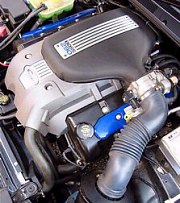 GT-P
is a heavyweight boxer. It tips the scale at 1825kg, but it has enough
punch - 390 horsepower and 383 lbft of torque. Its heart is a 5.4-litre
V8, dubbed "290 Boss" (very Mustang-like), in which the number means
290kW
of maximum power. This engine is modified from the XR8's, with higher
compression
ratio (10.5:1), stronger crankshaft and con-rods, smoother intake and
exhaust,
higher valve lift etc. to squeeze out extra punch. Perhaps because of
its
long-stroke design (the V8 was originally designed for trucks), it does
not rev as sweetly as arch-rival HSV's 400hp LS1 V8 at the top end,
despite
of dohc 32 valves versus ohv 16 valves. However, it does deliver more
bottom-end
torque.
GT-P
is a heavyweight boxer. It tips the scale at 1825kg, but it has enough
punch - 390 horsepower and 383 lbft of torque. Its heart is a 5.4-litre
V8, dubbed "290 Boss" (very Mustang-like), in which the number means
290kW
of maximum power. This engine is modified from the XR8's, with higher
compression
ratio (10.5:1), stronger crankshaft and con-rods, smoother intake and
exhaust,
higher valve lift etc. to squeeze out extra punch. Perhaps because of
its
long-stroke design (the V8 was originally designed for trucks), it does
not rev as sweetly as arch-rival HSV's 400hp LS1 V8 at the top end,
despite
of dohc 32 valves versus ohv 16 valves. However, it does deliver more
bottom-end
torque. 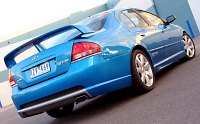 Find
an open road, the GT-P is easy to go fast. Its power delivery is
linear.
Its rear end is well tied to the ground, thanks to wide tyres,
multi-plate
clutch LSD and a high-threshold traction control. It doesn't have the
tail-happy
manner you expect for a torquey rear-drive machine. It stops quicker
than
its weight suggest, thanks to 355mm front and 330mm rear Brembo brakes.
In short, the GT-P is pretty obedient.
Find
an open road, the GT-P is easy to go fast. Its power delivery is
linear.
Its rear end is well tied to the ground, thanks to wide tyres,
multi-plate
clutch LSD and a high-threshold traction control. It doesn't have the
tail-happy
manner you expect for a torquey rear-drive machine. It stops quicker
than
its weight suggest, thanks to 355mm front and 330mm rear Brembo brakes.
In short, the GT-P is pretty obedient. 